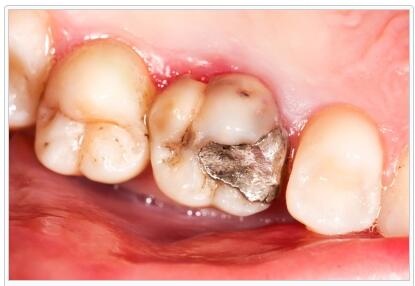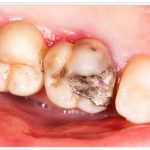Amalgam is a mercury-containing material that has been used as a tooth filling material for many decades because it is inexpensive, durable and relatively easy to process. Today, amalgam is considered questionable because it can lead to health problems such as amalgam allergies and amalgam poisoning.
What is an amalgam allergy?
If you have an amalgam allergy, you should definitely replace the amalgam fillings with other substances. Your dentist will provide you with comprehensive information about this.
According to AVIATIONOPEDIA.COM, an amalgam allergy is a contact allergy to amalgam fillings that causes discomfort to the oral mucosa. This allergy occurs only very rarely, it is assumed that only 0.01% of all people suffer from an amalgam allergy.
In people suffering from neurodermatitis , an amalgam allergy can cause the eczema to spread and deteriorate the skin where the skin comes into contact with the saliva.
Causes
Amalgam poisoning is also popularly referred to as an amalgam allergy, but it is not a real allergy.
Amalgam consists of around 50% mercury, which is toxic to the body. Other components are metals such as copper, zinc, silver and tin. Amalgam poisoning can lead to unspecific physical reactions such as a weakened immune system. It occurs when mercury is released when inserting or removing amalgam fillings or when amalgam fillings become porous.
Components of amalgam fillings then enter the gastrointestinal tract and bloodstream through the saliva. The mercury is stored in the liver , brain , kidneys , in the tissue and in the nervous system and thus triggers various health problems.
Symptoms, ailments & signs
An amalgam allergy can cause a number of symptoms and ailments. When an allergy sufferer comes into contact with the allergen, chronic fatigue , headaches and difficulty concentrating can occur, among other things . The metal is also suspected of promoting infections and causing skin eczema. Even muscle pain should be favored by the repeated contact with amalgam.
Acute there is a strong burning sensation on the tongue , combined with a metallic taste in the mouth. A contact allergy to amalgam fillings can cause discomfort to the oral mucosa and gums. The hypersensitive reaction leads to inflammation, itching, bleeding and, under certain circumstances, permanent tissue damage.
Repeated contact with the allergen can lead to infections and further discomfort. A typical secondary disease is inflammation of the gums, which manifests itself as painful redness and swelling . Most of the time there are secretions, bleeding and tears. This is accompanied by a pronounced bad breath .
In addition, an amalgam allergy causes the typical allergic reactions. For example, skin irritation, gastrointestinal complaints and eye irritation can occur, depending on which body regions come into contact with the metal. In extreme cases, an amalgam allergy can lead to anaphylactic shock .
Diagnosis & course
The prick test is an allergy test to check, for example, an allergic reaction to pollen or animal hair. Possible allergic substances are dripped onto the skin and then gently pierced with a lancet. After 20 minutes, the reddening of the skin and the size of the wheals are assessed.
An amalgam allergy is diagnosed using a patch test. During the patch test , which should only be carried out by an experienced dermatologist due to the wide range of possible reactions , a plaster with the substances to be tested is stuck on the patient’s back.
For example, allergic reactions to different types of mercury and amalgam alloys as well as to other ingredients in dental fillings such as plastics, other metals and cement can be tested. If eczema develops under the patch within three days, there is an allergy.
If an amalgam allergy is detected too late, it can lead to chronic inflammation, erosions and white discolouration in the oral cavity. In some cases, acute eczema also occurs shortly after new amalgam fillings have been placed.
Amalgam poisoning can be diagnosed with a blood or urine test, which measures the amount of mercury in the body. However, because mercury is mainly stored in tissue, these tests are not always meaningful. In natural medicine, amalgam poisoning is seen as the cause of many types of physical complaints, including chronic fatigue , susceptibility to infections , listlessness , autoimmune diseases and depressive moods .
However, it is difficult to prove that the symptoms are actually caused by poisoning from amalgam fillings. This is why not all health insurances currently recognize amalgam poisoning as a disease.
Complications
As a rule, an amalgam allergy can be treated relatively well, so that there are no consequential damages or further complications. The patients usually suffer from a strong burning sensation on the tongue and a metallic taste in the mouth. This is mainly due to the removal of amalgam fillings. Furthermore, the gums can become inflamed in various places.
Due to the inflammation, the patient can usually no longer consume food and fluids in the usual form. The amalgam allergy often leads to tiredness and a depressed mood. The affected person becomes susceptible to infections and thus more often sick.
The amalgam allergy is usually treated acutely by removing the fillings and attaching plastic fillings to the tooth. However, it can still take a certain amount of time before the entire amalgam has been broken down from the body. Furthermore, there are no further complications.
In the worst case, the amalgam allergy can develop into amalgam poisoning. When taking large amounts, the patient is given selenium as it binds the mercury and removes it from the body. Life expectancy is not reduced with an amalgam allergy.
When should you go to the doctor?
If all signs point to an amalgam allergy, a visit to the dentist or a dermatologist is inevitable. As a result, the amalgam allergy can aggravate existing diseases. But it can also trigger health consequences.
A patch test can determine whether there is actually an amalgam allergy. This is comparatively rarely the case, but a real allergy to dental materials such as amalgam should always be taken seriously. However, the symptoms and the results of the patch test may indicate chronic amalgam poisoning.
The treatment of an amalgam allergy can be carried out successfully nowadays. The therapy is often based on removing the amalgam seals at the dentist. If there is a real allergy, an application for reimbursement for the dental restoration can be submitted to the health insurance company. The attending physician will support this application with his diagnosis. He can also take further measures to prevent consequential damage. If necessary, this is followed by detoxification and the restoration of the immune system.
The natural medicine knows gentle detoxification and Ausleitungsverfahren. Therefore, it makes sense to consult an experienced alternative practitioner after removing the amalgam seals. This can help the patient through natural detoxification measures to support the body’s self-detoxification. Support for the stressed immune system is also useful.
Treatment & Therapy
The treatment method of choice for both amalgam allergies and amalgam poisoning is dental restoration, in which the amalgam fillings are replaced.
This dental restoration must be carried out with extreme care, because large amounts of mercury can be released in the process. In the case of an amalgam allergy, the health insurance pays for this dental restoration; in the case of amalgam poisoning, the patient has to pay for it himself. Ceramic fillings or almost pure gold fillings should be used as new tooth fillings. Inferior gold fillings that contain allergenic palladium or plastic fillings are not good alternatives.
As a further measure, selenium should be taken in the event of amalgam poisoning. Selenium binds mercury in such a way that it no longer has any harmful effects on the body. The consumption of zinc is recommended for any type of allergy.
Outlook & forecast
As a rule, an amalgam allergy does not lead to particular complaints if the person concerned refrains from contact with amalgam or from taking it. There are also no particular restrictions in the life and everyday life of the patient. The symptoms and complaints usually occur when the amalgam detaches from the dental fillings and thus enters the body. This can lead to a metallic taste in the mouth or a burning tongue.
Furthermore, those affected often suffer from headaches and general tiredness. Sometimes there are also various inflammations of the gums, which usually occur for no particular reason. If the amalgam is taken for a long time, this can have a negative effect on the internal organs of the person concerned, as amalgam is basically a poisonous material. Usually this can damage the kidneys, brain and liver. This will reduce the life expectancy of the patient.
It is usually not possible to treat the amalgam allergy. The affected person then has to forego dental fillings made of amalgam, whereby there are no particular restrictions.
Prevention
As a preventive measure, if you are allergic to amalgam, new fillings should be tested for their allergenic effect before they are inserted. This is how you avoid new contact allergies.
People suffering from amalgam poisoning should avoid any consumption of foods containing heavy metals, such as tuna and shrimp from polluted seas, as a preventive measure. Drinking water from old lead pipes and cigarette smoke can also exacerbate the symptoms. A lot of sport, healthy food and as little alcohol as possible are good for the liver and kidneys and thus promote the body’s self-detoxification.
Aftercare
An amalgam allergy only requires treatment if the typical symptoms occur. Those affected come into contact with metals that contain the alloy. Follow-up care aims to avoid the reaction. The responsibility for this lies with the patient. Scheduled follow-up examinations with a doctor are not provided after an initial diagnosis.
The pathological defense reaction is determined by an allergist. This usually carries out a patch test. Multiple surveys are only necessary in rare cases. Complications sometimes arise in elderly people who have had amalgam fillings. They suffer from discomfort until the alloys are replaced with ceramic or plastic components.
Today’s dentures dispense with the amalgam material because of the known side effects. Follow-up care is exclusively of a preventive nature. In addition to replacing stressed dentures, patients should also take a look at the origin of certain foods. Fish from polluted seas and contaminated water can also trigger an allergic reaction.
If large amounts get into the body, poisoning can occur. More severe complaints and complications are possible. The amalgam allergy usually does not affect everyday life. Contaminated metal components can be replaced without hesitation in Europe. Neither the quality of life nor the lifespan suffer.
You can do that yourself
If you suspect an amalgam allergy, you must first consult a doctor. Dental restoration is usually indicated, which can be supported by the person concerned with a few measures. First and foremost, it is important to have a healthy and balanced diet that meets the requirements of the dentist .
The patient should not ingest food and drinks that are excessively cold, hot, or otherwise irritating. In addition, good oral hygiene should be observed. In the first few days after an operation in particular, it is important to take good care of your teeth and oral cavity in order to avoid inflammation and similar complaints. The doctor responsible will prescribe a suitable mouthwash for the patient to prevent possible infections.
Dental restoration should be supported by taking selenium . The substance binds mercury and prevents harmful consequences for the body. It is often sufficient to take selenium through an adapted diet or dietary supplement. In severe cases, an infusion may be necessary. It depends on the amount of amalgam in the body, the patient’s health, and a few other factors. In addition, zinc should be taken regularly . The doctor must monitor the intake of supplements and adjust them in the event of side effects and interactions.









